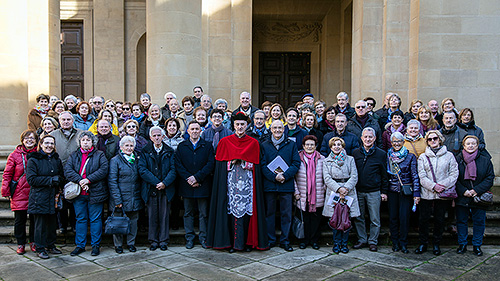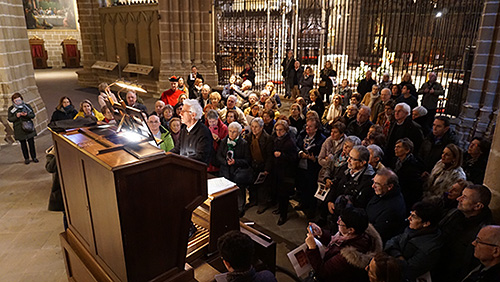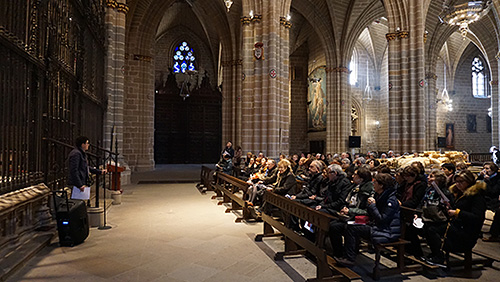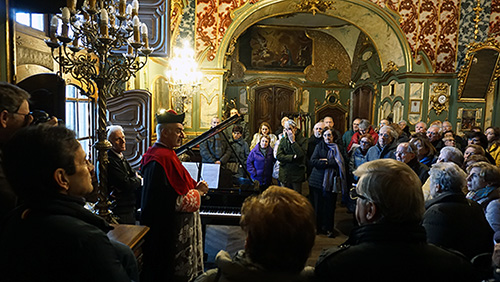Alejandro Aranda Ruiz, Ph.D. in Art History
Ricardo Fernández Gracia, Director of the Chair of Navarrese Heritage and Art.
Manuel Casado Velarde, University of Navarra
Carlos-Esteban Ayerra Sola, Dean of Pamplona
Navidad en la catedral de Pamplona<br><br>14 de diciembre de 2019

PHOTO: J. Case DN
Liturgy and ceremonial
Alejandro Aranda Ruiz
PhD in Art History
"Intona el señor deán el Nativitas Domini nostri Jesu Christi secundum carnem...".With these words the master of ceremonies of the cathedral of Pamplona, Mr. Desiderio Azcoita, indicated at the end of the 19th century the way in which the Calenda, the solemn proclamation with which Christmas began in the cathedral church on the morning of December 24, should be sung. This liturgical cycle, preceded by the time of preparation of Advent, began to take shape and color around December 18 with the feast of the Expectation or Virgen de la O and ended on February 2, feast of the Purification of the Virgin, as the popular adage "Hasta la Purificación, Pascuas son" (Until the Purification, Easter is Easter).
During this time, the cathedral was immersed in an intense liturgical activity that showed, more than at any other time of the year, the purpose of the cathedral temple and the Cathedral Chapter: to pay the most solemn worship to God. In this way, the canons of Pamplona, together with a legion of beneficiaries, chaplains, musicians, singers, sergeants, porters and dog catchers, made the great machinery of the cathedral work with the precision of a clock. During these weeks, countless ceremonies and acts of worship took place in the cathedral, in which the liturgy of the Universal Church and the "venerable and praiseworthy customs" of the church of Pamplona and its canons were intermingled. Thus, with solemn choral services, masses and cloister processions, the most important moments of this time were celebrated, including Christmas itself on December 25, the feast of the Innocents on December 28, the Circumcision on January 1 and the Epiphany on January 6. Some of these functions have survived to the present day as authentic relics of the past, such as the singing of the Calenda at the chapter mass on December 24 in the morning or the cloister procession on Epiphany day with the relic In presepio Domini and the statio on the ephemeral altar erected in the cloister in front of the well-known relief of the Three Wise Men of Perut.

PHOTO: J . Ignacio Riezu
Putting images to Christmas in the cathedral
Ricardo Fernández Gracia
University of Navarra
A set of representations of Christmas, from the leave Age average to the 18th century, make up a cultural heritage in which to see, look and read around iconographic styles and models that translate to the brush or the gouge the Gospel texts and other less orthodox ones, in relation to the arrival of Christ on earth.
The first example is one of the polychrome keystones of the eastern bay of the cloister, belonging to its first construction phase (1280-1318), perhaps destined to begin a cycle with the topic of the infancy of Christ, interrupted when the cloister was not continued on that side. It is very complete, with the Virgin lying on the bed, St. Joseph at her feet, the midwife with the Child in her arms and the animals exhaling their breath on another Child that appears in a manger in the form of an altar. To the same aesthetics and iconography belongs a miniature of the Breviary of 1332, from the time of bishop Barbazán, considered as the oldest liturgical guide of the diocese and of the cathedral of Pamplona, where Christmas is included as part of the distinguished or most excellent feasts together with Easter, Pentecost and the Assumption of the Virgin.
A pair of painted panels belong to the 16th century. The one of the altarpiece of the late Gothic altarpiece of the Santo Tomás doubt, made in 1507 at the expense of Pedro Marcilla de Caparroso, auditor of the royal accounts. The second is fully Renaissance, the work of the second third of the 16th century by an Italianate painter of possible Toledan affiliation. As a particularity, we will note the presence of the ashlar on which the Child is deposited, associated with the cornerstone of the prophecy of Isaiah (28:16), and the way in which the sacrifices are deposited on the altar, thus acquiring a sacramental character. One of the reliefs of the main altarpiece -today in the parish of San Miguel- made under the patronage of Bishop Antonio Zapata (1597) also represents the topic, in this case made by the Romanesque sculptor Pedro González de San Pedro.
Along with other small-format representations of the seventeenth and eighteenth centuries, the large canvas of the sacristy set of the painter Pedro Antonio de Rada (1762) gives us some clues to understand how Baroque painters faced the topic , from the naturalistic perspective not without some symbols in order to awaken in the viewer real games of wit and wit.

PHOTO: J. Ignacio Riezu
Poets sing Christmas
Manuel Casado Velarde
University of Navarra
The topic of Christmas, together with the Epiphany, has been the subject, since the beginnings of Spanish literature, of different literary genres: narration, theater, poetry. This last genre, perhaps the most linked to the popular report , has reached true poetic heights, poems that have been able to reflect the wonder and joy for the Birth of the Son of God, Jesus of Nazareth.
As with other arts, poetic expression, when it is truly poetic, always says something new and perennial about reality. Those who have been able to declare with wisdom their experiences about the mysteries of Christmas, enrich our interiority, so dazed and disoriented by the consumerist noise that surrounds these celebrations. These poems, unlike the sometimes excessively abstract language of doctrinal expositions, can provide the complement of "corporeality" proper to poetry, so appropriate to the human condition and consistent with faith in the Incarnation of the Word.
The following verses come to report from writers of the Golden Age such as St. Teresa of Jesus, Lope de Vega ("Zagalejo de perlas, / Hijo del Alba, / dónde vais, que hace frío / tan de mañana?"), Luis de Góngora ("Caído se le ha caído un clavel / hoy a la Aurora del seno: / ¡que glorioso que está el heno, / porque ha caído sobre él!")... But the inspiration of the so-called Christmas cycle, which has the Holy Family as its protagonist, has never ceased to produce poetic compositions. There are our contemporaries Gerardo Diego, Ernestina de Champourcin, Luis Rosales, García Nieto, the brothers Carlos and Antonio Murciano or José Antonio Muñoz Rojas.
Without forgetting, as far as Navarre is concerned, Francisco Navarro Villoslada, in the 18th century; and in more recent times, Martínez Baigorri, José María Pérez-Salazar, Víctor Manuel Arbeloa or Ángel Urrutia, just to mention a few. To the latter we owe the following beginning of the sonnet "Paisaje de la Navidad": "Sobre un manso manesebre Dios se atreve / a ser carne mortal, a la locura / de hacer con nuestro barro su hermosura / mientras cae el silencio de la nieve".

PHOTO: J. Ignacio Riezu
meeting with Christmas
Carlos-Esteban Ayerra Sola
Dean of Pamplona
With the help of the Chair of Heritage and Navarrese Art of the University of Navarra and Diario de Navarra, we are going to meet in the Cathedral of Pamplona, to anticipate Christmas, through faith, art, poetry, music...
When we follow the Path that leads us to Christmas, our gaze and memories are recreated in the Night in which the angels sang: Glory to God in heaven and peace on earth to the men he loves... and the shepherds said: Let's go... and let's see that event. That going and beholding, I think, give two clues:
1st) The human and Christian condition demands that we live in a permanent search for more and better goals. Thus:
- As pilgrims, we must know where we are going. Always walking towards Bethlehem, that is, towards the Truth, towards Jesus. And for this reason, the shepherds who go to Bethlehem are the best symbol of our condition, of our commitment and of our identification with the Lord.
- As pilgrims, we must always move forward: more way, more truth, more knowledge, more love. Here too the shepherds of Bethlehem give us a lesson. Their going to Bethlehem was so strong and determined that they beheld the sun in the middle of the night.
- As pilgrims, we have to count on difficulty. The shepherds counted on the cold and the shadows of the night. But they advanced with enthusiasm and arrived at the cave.
- As pilgrims, we have to share with our brothers and sisters, so that the journey may be more bearable and enriching. This is also shown to us by the shepherds of Bethlehem: they went together, sharing their enthusiasm and difficulties, under the light of the stars and following the song of the angels.
2) It is a matter of seeing this event; a seeing that is to understand, contemplate and live. They saw deeply, and discovered in the newborn the Messiah.
It is the gaze that reaches the heart. That deep look at the Mystery will make us go through life with a renewed soul, enriched and full of hope.
I hope that the visit to the Cathedral on the 14th will set everyone on the way: let's go to Bethlehem, and it will be a path of contemplation: let's look at this event.
